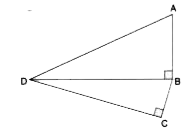ABCD is a trapezium such that AB and DC are parallel and BC is perpendicular to them. If BC=1 cm, CD=2 cm and ∠ADB=45∘, then the lengths of AB is (in cm)
125
85
53
163
The correct Answer is:C
To solve the problem, we need to find the length of AB in the trapezium ABCD where AB is parallel to DC, BC is perpendicular to them, and we have the following information:
- BC = 1 cm
- CD = 2 cm
- Angle ADB = 45°
1. Draw the trapezium ABCD:
- Label the points A, B, C, and D such that AB is parallel to DC and BC is perpendicular to both.
- Mark BC = 1 cm vertically and CD = 2 cm horizontally.
2. Identify the triangle BCD:
- In triangle BCD, we can use the Pythagorean theorem to find the length of BD.
- BD² = BC² + CD²
- Substituting the values: BD² = (1 cm)² + (2 cm)² = 1 + 4 = 5
- Therefore, BD = √5 cm.
3. Identify angles in triangle ADB:
- Since AB is parallel to DC, angle ADB = angle DBC = 45° (alternate interior angles).
- Let angle ABD = α. Then, angle ADB + angle ABD + angle DAB = 180°.
- Thus, angle DAB = 180° - 45° - α = 135°.
4. Use the sine rule in triangle ADB:
- According to the sine rule, we have:
ABsin(45°)=BDsin(135°)
- We know that sin(45°) = 1/√2 and sin(135°) = sin(180° - 45°) = sin(45°) = 1/√2.
5. Substituting values into the sine rule:
- Substitute the known values into the sine rule:
AB1√2=√51√2
- Rearranging gives:
AB=√5
6. Final calculation:
- Since we have the expression for AB, we can simplify:
AB=√5⋅1√2=√5√2=√102
7. Conclusion:
- The length of AB is 53 cm.
- CD = 2 cm
- Angle ADB = 45°
- Label the points A, B, C, and D such that AB is parallel to DC and BC is perpendicular to both.
- Mark BC = 1 cm vertically and CD = 2 cm horizontally.
- In triangle BCD, we can use the Pythagorean theorem to find the length of BD.
- BD² = BC² + CD²
- Substituting the values: BD² = (1 cm)² + (2 cm)² = 1 + 4 = 5
- Therefore, BD = √5 cm.
- Since AB is parallel to DC, angle ADB = angle DBC = 45° (alternate interior angles).
- Let angle ABD = α. Then, angle ADB + angle ABD + angle DAB = 180°.
- Thus, angle DAB = 180° - 45° - α = 135°.
- According to the sine rule, we have:
ABsin(45°)=BDsin(135°)
- We know that sin(45°) = 1/√2 and sin(135°) = sin(180° - 45°) = sin(45°) = 1/√2.
- Substitute the known values into the sine rule:
AB1√2=√51√2
- Rearranging gives:
AB=√5
- Since we have the expression for AB, we can simplify:
AB=√5⋅1√2=√5√2=√102
- The length of AB is 53 cm.
Topper's Solved these Questions
- TRIGNOMETRIC FUNCTIONS BOOK - AAKASH INSTITUTE ENGLISHCHAPTER - TRIGNOMETRIC FUNCTIONS EXERCISE - Section-C (Objective Type Questions More than one options are correct )
45 Videos
- TRIGNOMETRIC FUNCTIONS BOOK - AAKASH INSTITUTE ENGLISHCHAPTER - TRIGNOMETRIC FUNCTIONS EXERCISE - Section D (Linked Comprehension Type Questions)
27 Videos
- TRIGNOMETRIC FUNCTIONS BOOK - AAKASH INSTITUTE ENGLISHCHAPTER - TRIGNOMETRIC FUNCTIONS EXERCISE - Assignment Section-B (Objective Type Questions (One option is correct))
1 Videos
- THREE DIMENSIONAL GEOMETRY BOOK - AAKASH INSTITUTE ENGLISHCHAPTER - THREE DIMENSIONAL GEOMETRY EXERCISE - ASSIGNMENT SECTION - J
10 Videos
- VECTOR ALGEBRABOOK - AAKASH INSTITUTE ENGLISHCHAPTER - VECTOR ALGEBRAEXERCISE - SECTION-J (Aakash Challengers Questions)
5 Videos
Similar Questions
ABCD is a trapezium such that ABandCD are parallel and BC⊥CD. If /_ADB= theta , BC =p and CD=q, then AB is equal to
View SolutionAP, AQ and BC are tangents to the circle. If AB = 5 cm, AC = 6 cm and BC = 4 cm, then the length of AP (in cm) is
View SolutionAP, AQ and BC are tangents to the circle. If AB = 5 cm, AC = 6 cm and BC = 4 cm, then the length of AP (in cm) is
View SolutionABCD is a trapezium such that AB and CD are parallel and BC⊥CD. If ∠ADB=θ,BC=pandCD=q, then AB is equal to
View SolutionIn the given figure, AB and DE are perpendiculars to BC

If AB = 6 cm, DE = 4 cm and AC = 15 cm. Calculate CD.
View SolutionConstruct a quadrilateral ABCD, when :
AD=AB=4cm,BC=2.8cm,CD=2.5cmand angleBAD=45∘.
View SolutionIn the given figure, AB and DE are perpendicular to BC.

(iI) If AB = 6 cm, DE = 4 cm and AC = 15 cm. Calculate CD.
View SolutionIn the figure, ABCDE is a pentagon with BE∣∣CD and BC∣∣DE. BC is perpendicular to CD. AB= 5cm, AE=5cm, BE= 7cm, BC= x-y and CD= x+y. If the perimeter of ABCDE is 27cm. find the value of x and y, given x,y,≠0
View SolutionIn the given figure, AB∣∣CD,AB=7cm,BD=25cmandCD=17cm, find the length of side BC.

View SolutionThe given figure shows a quadrilateral ABCD in which AD =13 cm, DC= 12 cm, BC=3 cm and ∠ABC=∠BCD=90∘. Calculate the length of AB.

View Solution
